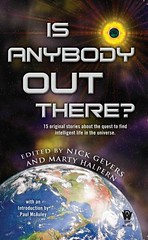 While attending SETIcon II this past weekend, one of the attendees, who was purchasing a copy of my co-edited anthology Is Anybody Out There?
While attending SETIcon II this past weekend, one of the attendees, who was purchasing a copy of my co-edited anthology Is Anybody Out There?
In preparation for SETIcon, I had previously ordered a number of copies of Is Anybody Out There? direct from Penguin Group (USA) Inc. Aside from checking that the number of books in the box was accurate and that none were damaged, well, that was as far as my keen observations went.
I've tried to scan the covers to show the differences, but the glare and all prohibits such distinctions. So, I will do my best to explain.
For all you completists out there: What we discovered is that the first printings had a matte-finish cover, whereas the second printings had a glossy cover, with a press line on the left side of the cover about three-sixteenths of an inch from the edge. Another way of describing a press line (possibly "press line" is not the correct term, but that's how I know it) might be a manufactured/built-in reading crease near the left edge on the front cover.
Also, the first printings have the full number line 1 through 8, whereas the second printings begin with the number 2.
But wait, there's more! When I returned home that evening I pulled out my own first printing of IAOT? -- a copy that I had received in 2010 when the book was published -- and verified the full number line. This copy has a glossy cover but no press line.
So, we have two different covers on the first printing: glossy and matte finish; and a different cover than either of those on the second printing: glossy with a press line.
Is anybody out there? Does anyone really care?
Unfortunately, I had no knowledge that the book was going back to press. Had I known I would have alerted the publisher to the two typos (at least the only two that I am aware of) and asked that they be corrected. One typo is in the David Langford story, "Graffiti in the Library of Babel," and the other is in the Ray Vukcevich story, "One Big Monkey." Sorry, guys....







